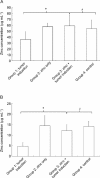High-dose dietary zinc promotes prostate intraepithelial neoplasia in a murine tumor induction model
- PMID: 20010849
- PMCID: PMC3739088
- DOI: 10.1038/aja.2009.74
High-dose dietary zinc promotes prostate intraepithelial neoplasia in a murine tumor induction model
Abstract
To evaluate the role of high-dose dietary zinc in the process of prostate malignancy, 60 Sprague-Dawley rats were randomly divided into four groups: tumor induction with carcinogen and hormone (group 1), oral zinc administration without tumor induction (group 2), oral zinc administration with tumor induction (group 3) and a control without zinc administration or tumor induction (group 4). Zinc was supplied orally in the form of zinc sulfate heptahydrate dissolved in drinking water to groups 2 and 3 for 20 weeks. Although the serum level of zinc measured at 20 weeks was maintained similarly in each group (P = 0.082), intraprostatic zinc concentrations were statistically different. Group 1 prostates contained the least amount of zinc in both the dorsolateral and ventral lobes at levels of 36.3 and 4.8 microg g(-1), respectively. However, in group 3, zinc levels increased in both lobes to 59.3 and 12.1 microg g(-1), respectively, comparable with that of group 4 (54.5 +/- 14.6 and 14.1 +/- 2.4 microg g(-1)). In spite of these increases in zinc concentration, the prevalence of prostate intraepithelial neoplasm was rather increased in group 3 (53.3% and 46.7%) compared with group 1 (33.3% and 33.3%) in both dorsolateral and ventral prostate lobes. Although prostate intraepithelial neoplasm did not develop in any prostate in group 4, zinc administration did induce prostate intraepithelial neoplasm in group 2 (46.7% and 40.0%). Thus, although high dietary zinc increased intraprostatic zinc concentrations, it promoted, instead of preventing, prostate intraepithelial neoplasm in a murine prostate malignancy induction model.
Figures


Similar articles
-
Protective effect of zinc on N-methyl-N-nitrosourea and testosterone-induced prostatic intraepithelial neoplasia in the dorsolateral prostate of Sprague Dawley rats.Exp Biol Med (Maywood). 2011 Sep;236(9):1012-21. doi: 10.1258/ebm.2011.010392. Epub 2011 Aug 24. Exp Biol Med (Maywood). 2011. PMID: 21865407
-
Changes in serum and prostatic zinc concentrations in rats after intraprostatic injection of zinc: Comparison of two forms of zinc delivery.Int J Urol. 2002 Dec;9(12):681-7. doi: 10.1046/j.1442-2042.2002.00543.x. Int J Urol. 2002. PMID: 12492952
-
Morphological and hormonal changes in the ventral and dorsolateral prostatic lobes of rats treated with finasteride, a 5-alpha reductase inhibitor.Prostate. 1998 May 15;35(3):157-64. doi: 10.1002/(sici)1097-0045(19980515)35:3<157::aid-pros1>3.0.co;2-e. Prostate. 1998. PMID: 9582084
-
Influence of diethylstilbestrol, Leuprolelin (a luteinizing hormone-releasing hormone analog), Finasteride (a 5 alpha-reductase inhibitor), and castration on the lobar subdivisions of the rat prostate.Prostate. 1996 Jul;29(1):1-14. doi: 10.1002/(SICI)1097-0045(199607)29:1<1::AID-PROS1>3.0.CO;2-K. Prostate. 1996. PMID: 8685049
-
Progression of prostatic intraepithelial neoplasia to early invasive adenocarcinoma.Eur Urol. 1996;30(2):145-52. doi: 10.1159/000474164. Eur Urol. 1996. PMID: 8875195 Review.
Cited by
-
Zinc dysregulation in cancers and its potential as a therapeutic target.Cancer Biol Med. 2020 Aug 15;17(3):612-625. doi: 10.20892/j.issn.2095-3941.2020.0106. Cancer Biol Med. 2020. PMID: 32944394 Free PMC article. Review.
-
The association between zinc and prostate cancer development: A systematic review and meta-analysis.PLoS One. 2024 Mar 20;19(3):e0299398. doi: 10.1371/journal.pone.0299398. eCollection 2024. PLoS One. 2024. PMID: 38507438 Free PMC article.
-
Post-diagnostic Zinc Supplement Use and Prostate Cancer Survival Among Men With Nonmetastatic Prostate Cancer.J Urol. 2023 Mar;209(3):549-556. doi: 10.1097/JU.0000000000003080. Epub 2022 Dec 1. J Urol. 2023. PMID: 36453265 Free PMC article.
-
Status and Interrelationship of Zinc, Copper, Iron, Calcium and Selenium in Prostate Cancer.Indian J Clin Biochem. 2016 Mar;31(1):50-6. doi: 10.1007/s12291-015-0497-x. Epub 2015 Apr 16. Indian J Clin Biochem. 2016. PMID: 26855488 Free PMC article.
References
-
- Neuhouser ML, Kristal AR, Patterson RE, Goodman PJ, Thompson IM.Dietary supplement use in the Prostate Cancer Prevention Trial. Implications for prevention trials Nutr Cancer 20013912–8. - PubMed
-
- Giovannucci E. Medical history and etiology of prostate cancer. Epidemiol Rev. 2001;23:159–62. - PubMed
-
- Feng P, Liang JY, Cuan ZX, Franklin RB. Zinc induces mitochondria apoptogenesis in prostate cells. Mol Urol. 2006;4:31–5. - PubMed
MeSH terms
Substances
LinkOut - more resources
Full Text Sources

